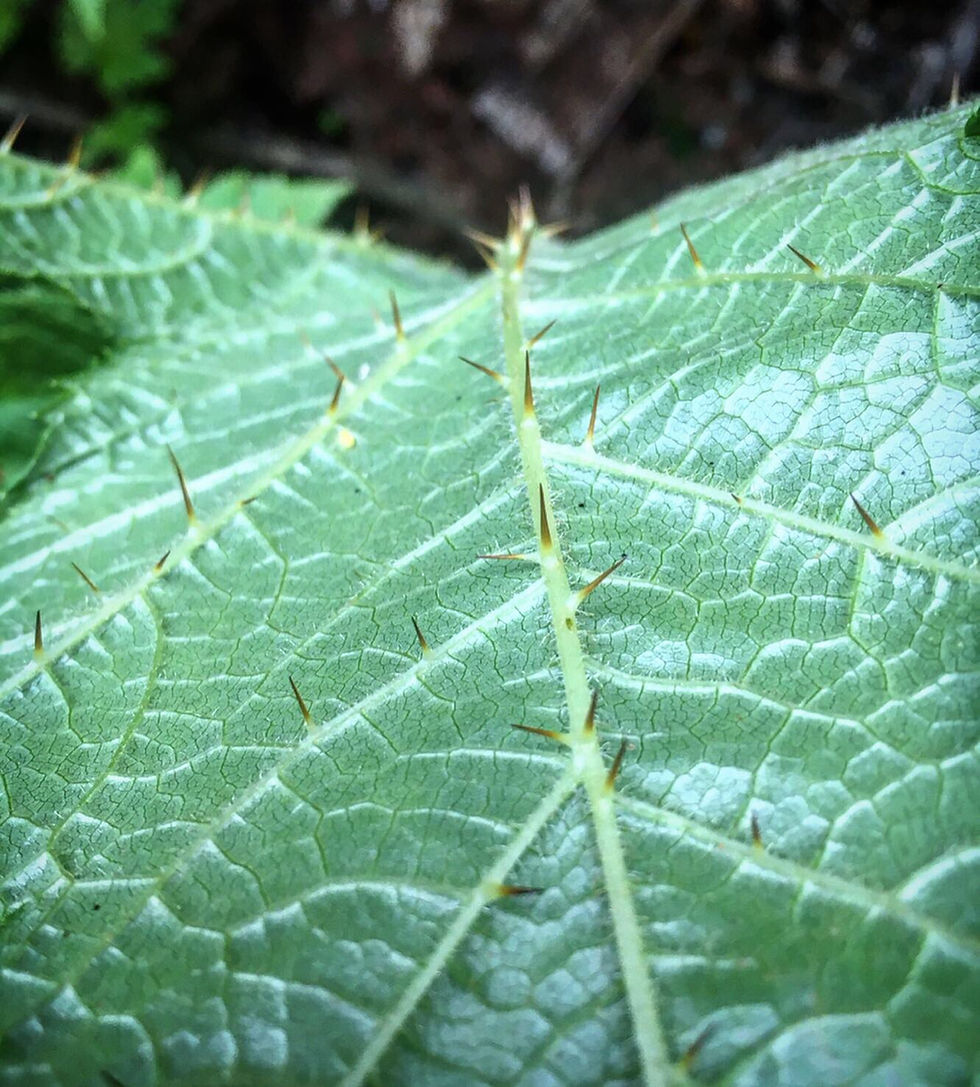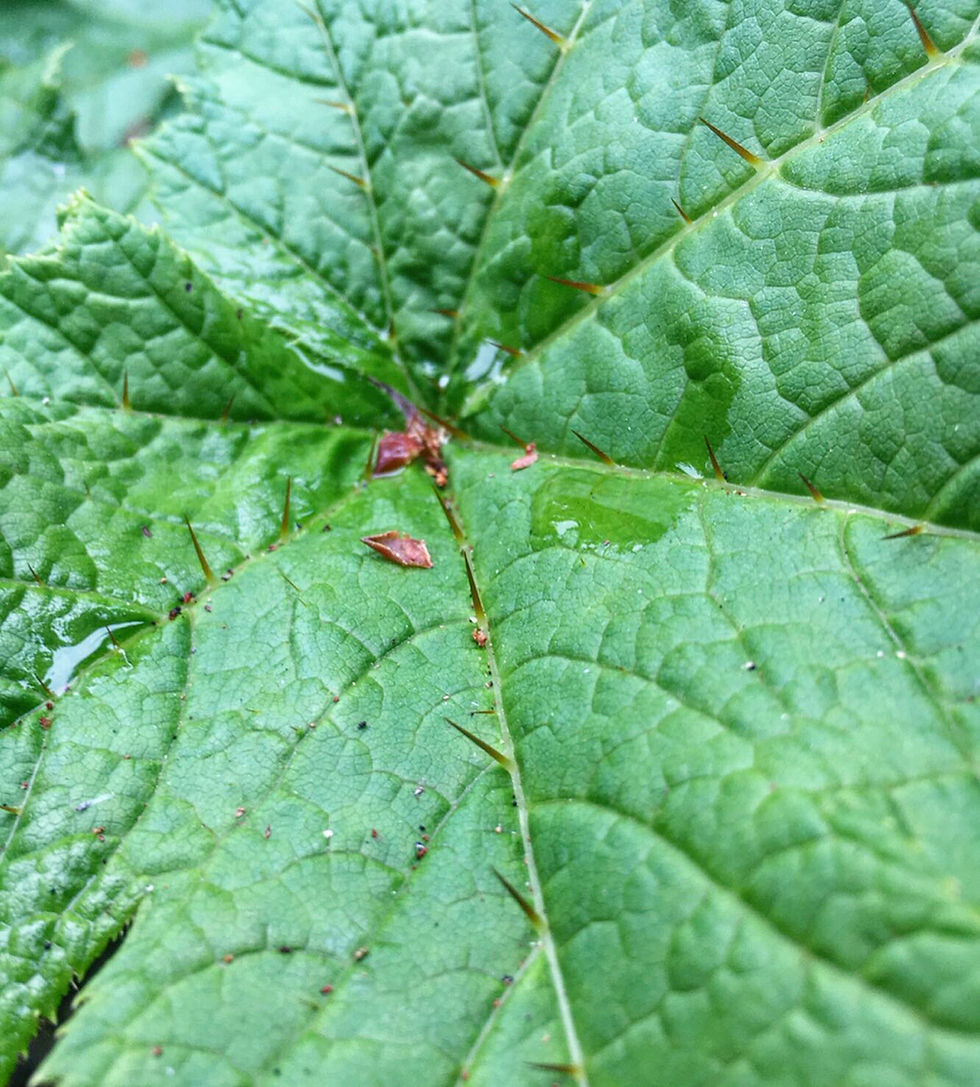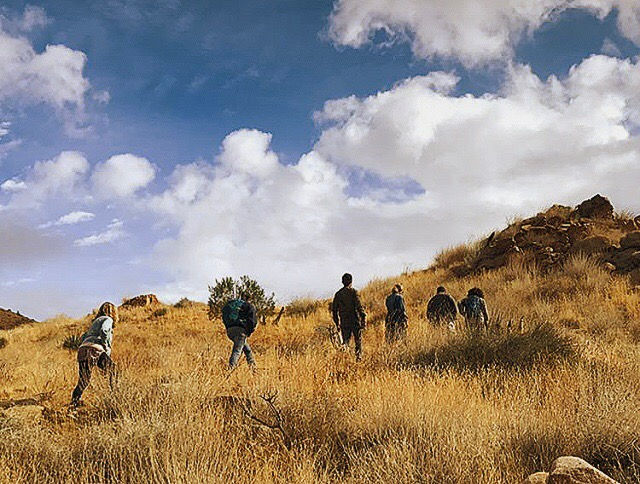Oplopanax horridus can the Popularity be its Demise?
- Christina Every Leaf Speaks Botanical Studies
- Aug 12, 2019
- 6 min read

Oplopanax horridus (awp-lo-PAN-ax HOR-id-us) Devils Club is a plant that I met last summer when camping in the Cascades in Oregon. It was a plant that I was excited to meet because I had read and heard a lot about it. Last summer my partner had taken me out to the Western Cascades for an overnight camping trip and on a walk he pointed out Devils Club, he told me to look at the leaf, instead I gently took the leaf in my hand unaware of the many spines and soon discovered the numerous of spines dressing the leaves alongside the veins of the leaf. I am used to prickles and spines coming from the Mojave Desert in the South West so it was not an unfamiliar pain. Now fast forward a year later Oplopanax horridus is a plant that we have been learning about in our field botany class at Columbines School of Botanical Studies. Coming from the Mojave Desert, many of these plants that I am studying here in the PNW do not grow in the desert, some overlap in other areas of California where there is more water or where it is not so hot.
Devils Club is a plant which prickles (spines) remind me of many flora back home that speak boundaries and demand respect like the various Opuntia Prickly Pear, Cylindropuntia Cholla, Senegalia Catsclaw to name a few. It seems as though many of the flora of the Mojave and Sonoran Desert have prickles. So, seeing a plant like Devils Club puts a smile on my face as its spines remind me of those back home but I have concern for the plant because of increasing popularity can be the demise of a plant revered as a sacred plant among many First Nations who work with it. I also feel I am out of my realm discussing First Nations peoples use of the plant as I am doing this based of research and not of personal experience or information told to me. So I write this with extreme respect for the First People of the regions who have used this plant for millennia.
If you are looking to discover the Traditional Western Medicinal uses of the plant, this is not what my post is about rather a place of concern for a plant that can not sustain mass wild harvesting so we should respect the plant especially if it is a plant that does not grow within our own region. Keeping in mind that there are many other plants that are not impacted by harvesting in our own regions that we can work with. WE DO NOT NEED the exotic popular plants.
INTRODUCTION
Oplopanax is a genus of plants in the Araliaceae or Ginseng family. There are three species within this genus and only one of those three O. horridus is in North America. Oplopanax japonicus is endemic in central Japan and Oplopanax elatus is distributed in the temperate regions of Northern China, the south of Primorye, northern part of the Korean Peninsula, and Russia. My focus will be on Oplopanax horridus and not the other species within the genus.

O. horridus also known as Devils Club is a deciduous armed shrub growing from 3 feet to just under 10 feet in height. The leaves are large palmately lobed and densely dressed with yellow spines along the veins of the leaves and stem.
The spines are anywhere between 5 - 10 mm (0.2 - 0.39 inches) in length and very easy to miss. If you turn the leaf over exposing the underside you will find numerous small spines along the vein of the leaf. The inflorescence are small greenish-white umbels in elongate panicles or racemes flowering from May to July depending upon elevation and latitude. The fruits are 2 to 3 seeded, bright red fleshy berries.

DISTRIBUTION
O.horridus is native to Alaska, to Oregon, east to north Idaho, Northwest Montana, Michigan and parts of North West British Columbia and Ontario. It is found in the under story of the moist coniferous woods. Oplopanax is a water indicator as it likes moist rich soil and thrives along water ways.
Oplopanas horridus is listed as threatened in Michigan in the USDA Threatened and Engendered Plants list. As of now it is not listed in any other state but still we must be mindful of use of plants especially of those that are popular.
The genus name Oplopanax is derived from the word hoplon, meaning tool or weapon, panax translated meaning panacea or "heal all" or plant, supposed to cure all diseases. Panax is also another genus of Araliaceae, the Ginseng family. Horridus translates to wild, frightful, rough, bristly, standing on end". My summing up of these translations for Oplopanax horridus is literally a plant that is of the wild, armed and equipped to heal.

Oplopanax horridus was and still is an important plant used by Indigenous People who live within its range. Its traditional Native uses of the plant was sought for both spiritual and medicinal use. Today you will find tinctures made with using the root and when I did a search for Devils Club tincture I did not find any other part of the plant being used, keep in mind that the leaf, stem, bark have also been used aside of the root for medicine. When a root is removed that is the end of that plant, so there is concern about this plant gaining popularity, as is discussed on an old episode on NPR's, Morning Edition "Devil's Club: A Medicine Cabinet for Alaska Tribe; Thorny Plant's Popularity May Endanger Its Sacred Role". PLEASE LISTEN to the podcast. Keep in mind this NPR episode aired on August 11, 2004, fifteen years ago! We need to step up and speak for the plants because not only is wildcrafting an issue but the logging of Old Growth forest which I will briefly discuss clearcuts in a bit. When I looked over ethnobotanical documents of Devils Club I found it interesting to learn of the many uses and preparations of the WHOLE plant use among various First Nations. For instance the Gitxsan people of North Western British Columbia use of hu'ums (Gitxsan name for Devils Club) decoctions of the stem were made for its use of knitting a broken bones, mashed bark with fern root, Abies (fir) bark, Pinus (pine) or Picea (spruce) gum, Lysichitum root (skunk cabbage), and applied warm to boils, ulcers, for rheumatism and lung hemorrhage. The inner bark of hu'ums is used fresh or dried for rheumatism, respiratory ailments and as a general tonic, for stomach ulcers and stomach pain, and for gynecologic cancers. Regular chewing of fresh hu'ums inner bark is believed to maintain good health and vigor. I am not encouraging the use of the plant by discussing ethnobotanical uses but merely trying to show folks that the root does have medicinal use but don't isolate it to only medicinal part of the plant, moreover the whole plant is and has been used. However note that the berries are toxic. (Gitksan Traditional Medicine: Herbs and Healing Leslie M. Johnson Goitesfeld and Beverly Anderson Gitksan-Wet'suwet'en Tribal Council 1988)

What other factors can impact the plants???? CLEARCUTS, I am a newbie to the PNW while I am here studying at Columbines School of Botanical Studies and one thing that we have been studying are the ecosystems including the clearcuts and associated plants that come back after a clearcut.. I have been observing the various plants that are associated with clearcuts and the impact clearcuts can have and I thought it would impact Devils Club but I found while researching clearcuts and Devil’s Club that they are able to survive or recover through vegetative sprouting of damaged Devils Club plants after logging. Provided logging practices don’t impact the health of the forest floor to the extent that regrowth and clonal spread of Devils Club stems is inhibited. Old Growth forest have the largest of stems of this slow growing shade-tolerant plant and older clearcuts would support larger stems more than recent clearcuts. Other factors are important for instance large stems are difficult to find in the first ten years after a clearcut, The extent of stem damage from logging also affect the success and recovery of healthy Devils Club stems. These results are consistent with the literature which describes devil’s club as a shade-tolerant species that is sensitive to fire and grows well on moist sites (Recovery of Oplopanax horridus an Important Ethnobotanical Resource, after Clearcut Logging in Northwestern British Columbia) (Alaback 1980, Burton 1998, Howard 1993, Klinka et al. 1989)

If you live within the hardiness zones of Oplopanax and have a shaded boggy garden area, consider trying to cultivate your own. I found some information on how to HERE and if you are inclined to purchase it, I came across Nass Valley Wild Medicine while searching the name Wa'ums which means Devils Club in the Nisga'a peoples languge a website offering plant medicines and bath bombs. Plant medicines that are gathered and made by the Nisga'a people. If we are called to work with this plant, support those who have a connection, history and knowledge
I copied this from their home page;













Comments